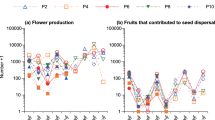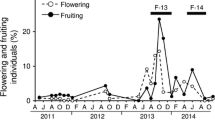Abstract
This study evaluates the fruiting phenology, fruit traits, and seed dispersal in two Pilosocereus (Cactaceae) species that are widely distributed in Caatinga vegetation. We monitored the fruiting phenology of Pilosocereus gounellei and Pilosocereus chrysostele on a monthly basis for a period of 4 years (45 months from March 2009 to November 2012), including 30 individuals of each species. We also carried out focal observations, captured dispersers, and conducted germination tests, to identify the effective seed dispersers of these species. Both species exhibited sub-annual fruiting patterns and high fruiting synchrony index (O jk 0.62), with peaks occurring from February to May for P. gounellei and February to April for P. chrysostele. In all, 248 visits by seven bird and two lizard species were recorded for P. gounellei, and 104 visits by five bird species were recorded for P. chrysostele. The two species shared five seed dispersers. The finch Lanio pileatus was the most frequently visiting bird species. The number of visits to the fruits of P. gounellei was higher than to the fruits of P. chrysostele. Passage of seeds through the digestive tracts of all bird species significantly increased the germination rate for P. chrysostele, whereas for P. gounellei, the birds Forpus xanthopterygius and L. pileatus decreased germination rates. Sub-annual fruiting patterns, similar fruit morphology, and high synchronous fruiting are factors that favor resource sharing among the dispersers of Pilosocereus in the Caatinga.



Similar content being viewed by others
References
Araujo HFP (2009) Amostragem, Estimativa de Riqueza de Espécies e Variação Temporal na Diversidade, Dieta e Reprodução de Aves em Área de Caatinga, Brazil. Universidade Federal da Paraíba, João Pessoa, Brazil. PhD Dissertationp, p 198
Bravo-Hollis H, Sánchez-Mejorada H (1978) Las Cactáceas de México. Universidad Nacional Autónoma de México, México
Brito-Kateivas KS, Corrêa MM (2012) Ants interacting with fruits of Melocactus conoideus Buining & Brederoo (Cactaceae) in southwestern Bahia, Brazil. Biotemas 25:153–159. doi:10.5007/2175-7925.2012v25n3p153
Byrne MM, Levey DJ (1993) Removal of seeds from frugivore defecations by ants in a Costa Rican forest. Vegetatio 108:363–374
Christianini AV, Oliveira PS (2010) Birds and ants provide complementary seed dispersal in a neotropical savanna. J Ecol 98:573–582. doi:10.1111/j.1365-2745.2010.01653.x
Christianini AV, Mayhé-Nunes AJ, Oliveira PS (2007) The role of ants in the removal of non-myrmecochorous diaspores and seed germination in a Neotropical savanna. J Trop Ecol 23:343–351. doi:10.1017/S0266467407004087
Christianini AV, Mayhé-Nunes AJ, Oliveira PS (2012) Exploitation of fallen diaspores by ants: are there ant-plant partner choice? Biotropica 44:360–367. doi:10.1111/j.1744-7429.2011.00822.x
Coates-Estrada R, Estrada A (1988) Frugivory and seed dispersal in Cymbopetalum baillonii (Annonaceae) at Los Tuxtlas, Mexico. J Trop Ecol 4:157–172
Figueira JEC, Vasconcellos-Neto J, Garcia MA, Souza ALT (1994) Saurocory in Melocactus violaceus (Cactaceae). Biotropica 26:295–301. doi:10.2307/2388850
Fonseca RBS, Funch LS, Borba EL (2012) Dispersão de sementes de Melocactus glaucescens e M. paucispinus (Cactaceae), no Município de Morro do Chapéu, Chapada Diamantina-BA. Acta Bot Bras 26:481–492. doi:10.1590/S0102-33062012000200024
Godínez-Álvarez H, Valiente-Banuet A (1998) Germination and early seedling growth of Tehuacan Valley cacti species: the role of soils and seed ingestion by dispersers on seedling growth. J Arid Environ 39:21–31. doi:10.1006/jare.1998.0376
Godínez-Álvarez H, Valiente-Banuet A, Rojas-Martinez A (2002) The role of seed dispersers in the population dynamics of the columnar cactus Neobuxbaumia tetetzo. Ecology 83:2617–2629. doi:10.1890/0012-9658(2002)083[2617:TROSDI]2.0.CO;2
Goettsch B, Hilton-Taylor C, Cruz-Piñón G, Duffy JP, Frances A, Hernández HM, Inger R, Pollock C, Schipper J, Superina M, Taylor NP (2015) High proportion of cactus species threatened with extinction. Nat Plants. doi:10.1038/nplants.2015.142
Gomes VGN, Quirino ZGM, Machado IC (2013) Pollination and seed dispersal of Melocactus ernestii Vaupel subsp. ernestii (Cactaceae) by lizards: an example of double mutualism. Plant Biol 16:315–322. doi:10.1111/plb.12063
Gomes VGN, Quirino ZGM, Araujo HF (2014) Frugivory and seed dispersal by birds in Cereus jamacaru DC. ssp. jamacaru (Cactaceae) in the Caatinga of Northeastern Brazil. Braz J Biol 74:32–40. doi:10.1590/1519-6984.15312
Gomes VGN, Meiado MV, Quirino ZGM, Machado IC (2016) Seed removal by lizards and effect of gut passage on germination in a columnar cactus of the Caatinga, a tropical dry forest in Brazil. J Arid Environ 135:85–89. doi:10.1016/j.jaridenv.2016.08.013
Holland JN, Molina-Freaner F (2012) Hierarchical effects of rainfall, nurse plants, granivory and seed banks on cactus recruitment. J Veg Sci 24:1053–1061. doi:10.1111/jvs.12021
Jordano P, Schupp EW (2000) Determinants of seed disperser effectiveness: the quantity component and patterns of seed rain for Prunus mahaleb. Ecol Monogr 70:591–615
Kelly D, Ladley JJ, Robertson AW (2004) Is dispersal easier than pollination? Two tests in New Zealand Loranthaceae. N Z J Bot 42:89–103. doi:10.1080/0028825X.2004.9512892
Leal IR, Oliveira PS (1998) Interactions between fungus-growing ants (Attini), fruits, and seeds in cerrado vegetation in southeast Brazil. Biotropica 30:170–178. doi:10.1111/j.1744-7429.1998.tb00052.x
Leal IR, Wirth R, Tabarelli M (2007) Seed dispersal by ants in semi-arid Caatinga of Northeast Brazil. Ann Bot 99:885–894. doi:10.1093/aob/mcm017
Lucena CM, Costa GGS, Carvalho TKN, Guerras NM, Quirino ZGM, Lucena RFP (2012) Uso e conhecimento de cactáceas no município de São Mamede (Paraíba, Nordeste do Brazil). BioFar 121–134
Maguire JD (1962) Speed of germination-aid in selection and evolution for seedling emergence and vigor. Crop Sci 2:176–177
Meiado MV (2012) Germinação de sementes de cactos do Brazil: fotoblastismo e temperaturas cardeais. Abrates 22:20–22
Meiado MV, Silva FFS, Barbosa DCA, Siqueira-Filho JA (2012) Diásporos da Caatinga: Uma revisão. In: Siqueira-Filho JA (ed) A Flora das Caatingas do Rio São Francisco—História Natural e Conservação. Andrea Jakobsson Estúdio, Rio de Janeiro, pp 306–365
Motta-Junior JC (1990) Estrutura trófica e composição das avifaunas de três habitats terrestres na região central do estado de São Paulo. Ararajuba 1:65–71
Munguía-Rosas MA, Jácome-Flores ME, Sosa VJ, Quiroz-Cerón LM (2009) Removal of Pilosocereus leucocephalus (Cactaceae, tribe Cereeae) seeds by ants and their potential role as primary seed dispersers. J Arid Environ 73:578–581. doi:10.1016/j.jaridenv.2008.12.017
Naranjo ME, Rengifo CG, Soriano PJ (2003) Effect of ingestion by bats and birds on seed germination of Stenocereus griseus and Subpilocereus repandus (Cactaceae). J Trop Ecol 19:19–25. doi:10.1017/S0266467403003031
Newstrom LE, Frankie GW, Baker HG (1994) A new classification for plant phenology based on flowering patterns in lowland tropical rain forest trees at La Selva, Costa Rica. Biotropica 26:141–159. doi:10.2307/2388804
Petit S (2001) The reproductive phenology of three sympatric species of columnar cacti on Curaçao. J Arid Environ 49:521–531. doi:10.1006/jare.2001.0801
Pianka ER (1973) The structure of lizard communities. Annu Rev Ecol Syst 4:53–74. doi:10.1146/annurev.es.04.110173.000413
Pimienta-Barrios E (1997) Prickly pear (Opuntia spp.): a valuable fruit crop for the semi-arid lands of Mexico. J Arid Environ 28:1–11. doi:10.1016/S0140-1963(05)80016-3
Pimienta-Barrios E, del Castillo RF (2002) Reproductive biology. In: Nobel PS (ed) Cacti and uses. University of California, Los Angeles, pp 163–183
Pizo MA, Galetti M (2010) Métodos e perspectivas da frugivoria e dispersão de sementes por aves. In: Matter SV, Straube FC, Accordi IA, Piacentini VQ, Cândido-Júnior JF (eds) Ornitologia e Conservação: Ciência Aplicada, Técnicas de Pesquisa e Levantamento. Technical Books, Rio de Janeiro, pp 493–504
Poulin B, Lefebvre G, McNeill R (1992) Tropical avian phenology in relation to abundance and exploitation of food resources. Ecology 73:2295–2309. doi:10.2307/1941476
Prado DE (2003) As Caatingas da América do Sul. In: Leal IR, Tabarelli M, Silva JMC (eds) Ecologia e conservação da Caatinga. Editora Universitária, Recife, pp 3–74
Quirino ZGM (2006) Fenologia, síndromes de polinização e dispersão e recursos florais de uma comunidade de Caatinga no cariri paraibano. Universidade Federal de Pernambuco, Recife, Brazil. PhD Dissertation, p 128
Ranal MA, Santana DG (2006) How and why to measure the germination process? Revista Brasileira de Botânica 29:1−11. doi:10.1590/S0100-84042006000100002
Rengifo CG, Naranjo ME, Soriano PJ (2007) Fruit consumption by birds and bats on two species of columnar cacti in a semi-arid Andean enclave of Venezuela. Caribb J Sci 43:254–259. doi:10.18475/cjos.v43i2.a10
Robertson AW, Trass A, Ladley JJ, Kelly D (2006) Assessing the benefits of frugivory for seed germination: the importance of the deinhibition effect. Funct Ecol 20:58–66. doi:10.1111/j.1365-2435.2005.01057.x
Rocha EA, Agra MF, Zappi DC, Taylor NP (2006) Lista anotada das Cactaceae no estado da Paraíba, Brazil. Bradleya 11:61–68
Rocha EA, Machado IC, Zappi DC (2007) Floral biology of Pilosocereus tuberculatus (Werderm.) Byles & Rowley: a bat pollinated cactus endemic from the “Caatinga” in Northeastern Brazil. Bradleya 25:129–144
Romão RL, Hughes FM, Vieira AMC, Fontes EC (2007) Autoecologia de cabeça-de-frade (Melocactus ernestii Vaupel) em duas áreas de afloramentos na Bahia. Revista Brasileira de Biociências 5:738–740
Ruíz A, Santos M, Cavellier J (2000) Estudio fenológico de cactáceas en el enclave seco de la Tatacoa, Colombia. Biotropica 32:397–407. doi:10.1111/j.1744-7429.2000.tb00486.x
Santos MPD (2004) As comunidades de aves em duas fisionomias da vegetação da Caatinga no Piauí. Ararajuba 13:104–110
Schlumpberger BO (2010) A survey on pollination modes in cacti and a potential key innovation. In: Patiny S (ed) Evolution of plant–pollinator relationships. Cambridge University, Cambridge, pp 301–319
Schupp EW (1993) Quantity, quality and the effectiveness of seed dispersal by animals. Vegetatio 108:15–29
Schupp EW, Jordano P, Gómez JM (2010) Seed dispersal effectiveness revisited: a conceptual review. New Phytol 188:333–353. doi:10.1111/j.1469-8137.2010.03402.x
Sick H (1997) Ornitologia Brasileira. Nova Fronteira, Rio de Janeiro
Soriano PJ, Naranjo ME, Rengifo CG, Figueira M, Rondon M, Ruíz RL (1999) Aves consumidoras de frutos de cactáceas columnares del enclave semiárido de Lagunillas, Mérida, Venezuela. Ecotropicos 12:91–100
Taylor NP, Zappi DC (2004) Cacti of eastern Brazil. Royal Botanic Gardens, London
Traveset A, Heleno R, Nogales M (2014) The ecology of seed dispersal. In: Gallagher RS (ed) Seeds: the ecology of regeneration in plant communities. CAB International, Wallingford, pp 62–93
Valiente-Banuet A, Bolongaro-Crevenna A, Briones O, Ezcurra E, Rosas M, Nunez H, Bernard G, Vazquez E (1991) Spatial relationship between cacti and nurse shrubs in a semiarid environment in Central Mexico. J Veg Sci 2:15–20. doi:10.2307/3235893
Van der Pijl L (1982) Principles of dispersal in higher plants. Springer, Berlim
Wheelwright NT (1991) How long do fruit-eating birds stay in the plants where they feed? Biotropica 23:29–40. doi:10.2307/2388685
Zappi DC (1994) Pilosocereus (Cactaceae) the genus in Brazil. Succ Pl Res 3:1–160
Zappi DC, Taylor NP, Santos MR, Larocca J (2016) Cactaceae. In Lista de Espécies da Flora do Brasil. Jardim Botânico do Rio de Janeiro. http://floradobrasil.jbrj.gov.br/jabot/floradobrasil/FB70
Acknowledgements
To the management of Almas Farm and Dr. Joel Queiroz, who provided fieldwork logistics. Dra Vênia Souza helped with seed germination experiments in the Laboratório de Sementes da Universidade Federal da Paraíba (UFPB). Suggestions from two anonymous reviewers greatly improved a previous version of this manuscript. The Brazilian Research Council (CNPq) granted an undergraduate scholarship to VGNG through the project ‘PELD/Caatinga: Estrutura e Funcionamento,’ and a research grant to ICM; later, Capes granted VGNG a Master’s scholarship.
Author information
Authors and Affiliations
Corresponding author
Additional information
Communicated by Timothy Bell.
Rights and permissions
About this article
Cite this article
Gomes, V.G.N., Meiado, M.V., Quirino, Z.G.M. et al. Synchronous fruiting and common seed dispersers of two endemic columnar cacti in the Caatinga, a dry forest in Brazil. Plant Ecol 218, 1325–1338 (2017). https://doi.org/10.1007/s11258-017-0771-5
Received:
Accepted:
Published:
Issue Date:
DOI: https://doi.org/10.1007/s11258-017-0771-5




